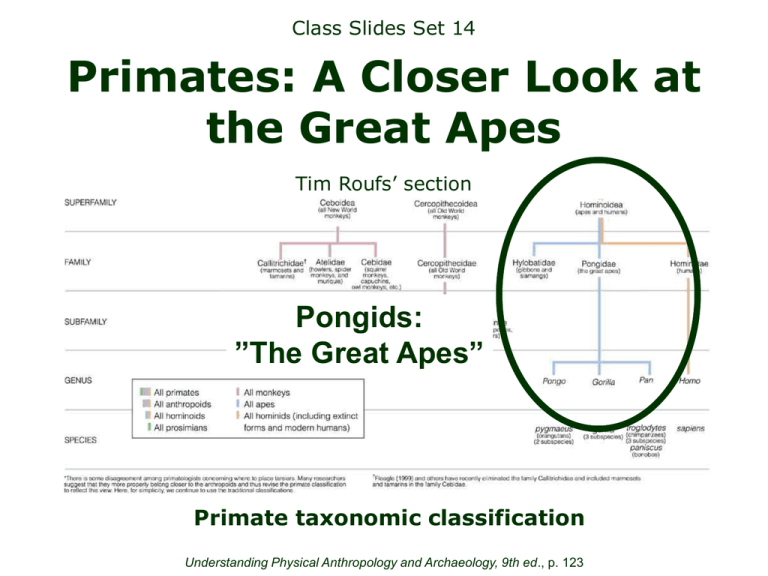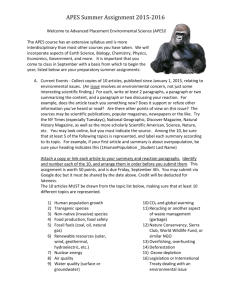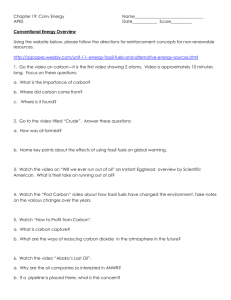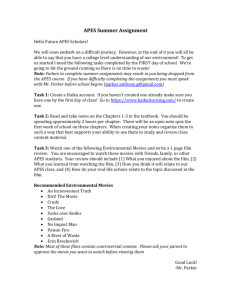Class Slides Set #14
advertisement

Class Slides Set 14 Primates: A Closer Look at the Great Apes Tim Roufs’ section Pongids: ”The Great Apes” Primate taxonomic classification Understanding Physical Anthropology and Archaeology, 9th ed., p. 123 Hominoidea Family Genus / Species Hylobates gibbon Pongids orangutan chimpanzee gorilla (“great apes”) Hominids Pongids (Great Apes) • orangutan (Pongo) • chimpanzee • gorilla (Gorilla) (Pan) Prehistoric Primates The three “great apes” (chimpanzees, orangutan, gorillas) probably share a common ancestor with hominids . . . Prehistoric Primates . . . although scientists still debate • The approximate time of separation • The physical nature of the ancestral lineage Prehistoric Primates The chimps and gorillas probably split from the human line ca. 7-5 mya (and the orangutans ca. 16-13 mya) Humankind Emerging, 7th ed., p. 33 Apes Apes are quite variable: A. Physically . . . B. Behaviorally . . . Apes A. Physically . . . apes differ in size, ranging from the small gibbon to the huge gorilla . . . gibbons humans bonobos orangutans chimps gorillas Campbell and Loy, Humankind Emerging, 8th ed, p. 138f Apes Some apes, like the gorilla, have considerable “sexual dimorphism” -- other apes have only a little . . . Glossary Sexual dimorphism – characteristic anatomical (and behavioral) difference between the males and the females of a species Apes B. The apes vary behaviorally: • some are “open” others are “closed” groups • some are “territorial” some are not Glossary Confusing concepts: “territory” . . . “home range” . . . “home base” . . . Glossary Confusing concepts: “territory” . . . • the area occupied and defended by individuals or groups of animals against “conspecifics” Glossary conspecifics — members of the same species Glossary Confusing concepts: “territory” . . . “home range” . . . “home base” . . . Glossary home range = total area used The area a primate group uses for foraging, sleeping, and so on in a year Home Range Humankind Emerging, 7th ed., p. 142 Chimpanzee and Bonobo Habitats Humankind Emerging, 7th ed., p. 155 Glossary Confusing concepts: “territory” . . . “home range” . . . “home base” . . . Glossary Home base = camps where hominid groups gather at evening for socializing, food sharing, and sleeping Apes Apes (for the most part) are “vegetarians” . . . (actually they’re “frugivors” / ”herbivores”) Prehistoric Cultures Diet classifications: • herbivorous (plants) • insectivorous (insects) – frugivorous (fruits) – graminivorous • carnivorous • omnivorous (grasses) (chiefly meats) (all of the above) Apes but chimpanzee has been observed hunting and eating meat . . . Apes Gombe chimpanzees devote about 10% of their time to the pursuit and consumption of game Apes chimpanzees usually hunt cooperatively and share their game Apes in fact, if a chimpanzee can not get others to join in, it will abandon the hunt -- Marvin Harris 1989, p. 38 Apes three to nine chimpanzees surround the prey animal Apes throughout the killing, distributing, and consuming prey animals, chimps display an unusual level of social interaction and excitement Apes chimpanzees hunt twentythree species of mammals ... Apes . . . including monkeys, baboons, galagos [“bush baby”], bush ducks, brush pigs, duikers [small African antelopes], mice, rats, squirrels, shrews, mongooses, and hyraxes -- Marvin Harris 1989, p. 37 Apes Why? Apes . . . to consume nutritious food on the ground not exploited effectively by fourhanded, tree-dwelling apes -- Marvin Harris 1989 Apes Baboons prefer • meat first • roots, seeds, fruits, and flowers second • and leaves and grass third -- Marvin Harris 1989, 37 Apes and chimps have been known to kill and eat other chimp’s children Apes aggression . . . http://www.world-science.net/exclusives/050209_warfrm.htm Glossary REM: “aggression” is always against conspecifics — members of the same species Apes Aggression? “Nature” – Biology (inherited) “Nurture” – Culture (learned) Apes many major evolutionary trends relate to “brachiation” / semi-brachiation, and upright orientation Glossary brachiation — an arboreal locomotor pattern featuring manual swinging from branch to branch Glossary arboreal — living in or among trees Skeleton of a brachiator (gibbon) Understanding Physical Anthropology and Archaeology, 9th ed., p. 121 Brachiation The Primates, Time-Life (1974), p. 72 White-handed gibbon Understanding Physical Anthropology and Archaeology, 9th ed., p. 131 Brachiation Ape and Monkey Arm Movements Humankind Emerging, 7th ed., p. 108 Primate (Macaque) hand Skeleton of a vertical clinger and leaper (indri) Understanding Physical Anthropology and Archaeology, 9th ed., p. 121 Skeleton of an arboreal New World monkey (bearded saki) Understanding Physical Anthropology and Archaeology, 9th ed., p. 121 Ape Locomotion Knuckle-walking Next: Bipedalism Legs/Feet and Pelvis




